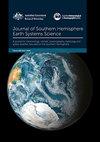APS2-ACCESS-C2: the first Australian operational NWP convection-permitting model
IF 3.6
4区 地球科学
Q1 Earth and Planetary Sciences
引用次数: 1
Abstract
The Australian Bureau of Meteorology’s ‘Australian Parallel Suite’ (APS) operational numerical weather prediction regional Australian Community Climate and Earth-System Simulator (ACCESS) city-based system (APS1 ACCESS-C1) was updated in August 2017 with the com-missioning of the APS2 ACCESS-C2. ACCESS-C2 runs over six regional domains. Significant upgrade changes included implementation of Unified Model 8.2 code; nesting in the 12 km resolution APS2 ACCESS-R2 regional model; and, importantly, an increased horizontal resolution from 4 to 1.5 km, enabling C2 to become the first Australian operational convection-permitting model (CPM). Traditional rainfall verification metrics and Fractions Skill Score show C2 forecast skill over ACCESS-C domains in summer and winter was generally, and in many cases, significantly better than C1. Case studies showed that C2 forecasts had better-detailed wind and precipitation fields, particularly at longer forecast ranges and higher rain rates. The improvements in C2 forecasts were principally due to its CPM ability to simulate high temporal and spatial resolution features, which continue to be of great interest to forecasters. C2 also laid the groundwork for the present day APS3 ACCESS-C forecast C3 and ensemble CE3 models and further development of higher resolution (down to 300 m) fire weather and urban models.APS2-ACCESS-C2:澳大利亚首个运行的NWP对流允许模式
澳大利亚气象局的“澳大利亚并行套件”(APS)业务数值天气预报区域澳大利亚社区气候和地球系统模拟器(ACCESS)城市系统(APS1 ACCESS- c1)于2017年8月随着APS2 ACCESS- c2的投入使用而更新。ACCESS-C2在六个区域域中运行。重大升级变更包括统一模型8.2代码的实现;在12km分辨率APS2 ACCESS-R2区域模型中嵌套;更重要的是,它将水平分辨率从4公里提高到1.5公里,使C2成为澳大利亚第一个可操作的对流允许模式(CPM)。传统的降雨验证指标和分数技能得分表明,夏季和冬季ACCESS-C域的C2预测技能普遍优于C1,在许多情况下显著优于C1。案例研究表明,C2预报具有更详细的风和降水场,特别是在更长的预报范围和更高的降雨率。C2预报的改进主要是由于其CPM模拟高时空分辨率特征的能力,这仍然是预报员非常感兴趣的。C2还为今天的APS3 ACCESS-C预报C3和集合CE3模式以及进一步发展更高分辨率(低至300米)的火灾天气和城市模式奠定了基础。
本文章由计算机程序翻译,如有差异,请以英文原文为准。
求助全文
约1分钟内获得全文
求助全文
来源期刊

Journal of Southern Hemisphere Earth Systems Science
Earth and Planetary Sciences-Oceanography
CiteScore
8.10
自引率
8.30%
发文量
0
审稿时长
>12 weeks
期刊介绍:
The Journal of Southern Hemisphere Earth Systems Science (JSHESS) publishes broad areas of research with a distinct emphasis on the Southern Hemisphere. The scope of the Journal encompasses the study of the mean state, variability and change of the atmosphere, oceans, and land surface, including the cryosphere, from hemispheric to regional scales.
general circulation of the atmosphere and oceans,
climate change and variability ,
climate impacts,
climate modelling ,
past change in the climate system including palaeoclimate variability,
atmospheric dynamics,
synoptic meteorology,
mesoscale meteorology and severe weather,
tropical meteorology,
observation systems,
remote sensing of atmospheric, oceanic and land surface processes,
weather, climate and ocean prediction,
atmospheric and oceanic composition and chemistry,
physical oceanography,
air‐sea interactions,
coastal zone processes,
hydrology,
cryosphere‐atmosphere interactions,
land surface‐atmosphere interactions,
space weather, including impacts and mitigation on technology,
ionospheric, magnetospheric, auroral and space physics,
data assimilation applied to the above subject areas .
Authors are encouraged to contact the Editor for specific advice on whether the subject matter of a proposed submission is appropriate for the Journal of Southern Hemisphere Earth Systems Science.
 求助内容:
求助内容: 应助结果提醒方式:
应助结果提醒方式:


